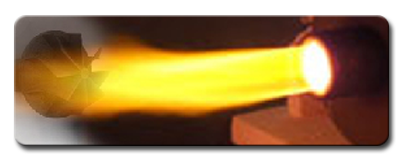CleanElectricFlame® Technology
Compare High Power CleanElectricFlame® use to Flame/Combustion
| CleanElectricFlame™. Nitrogen e-Ion Plasma™ Plume (possible species include N2, N2+, N+, N, e-). Discharge is into room air conditions. The heating system can be used for composite curing or heat treating on large surface areas of several square meters. |
 |  |
| Compare | Combustion Flame
(Conventional Plume) | MHI Advanced LIP System GEN 3
(CleanElectricFlame® Plume) |
| Emissions, Health & Environment | - Likely to produce CO2, SO2 and soot
- Uses combustion gas inputs of fuel and air, commonly requiring plumbing
- Typical 20,000 BTU/hr (5.858kW) burners produce about 22 moles of greenhouse gasses per hour
- Fossil fuel powered combustion often leads to toxic by products such as Carbon Monoxide
- Surfaces impacted by flame may be contaminated with small size soot-like particles.
Pounds of Carbon Dioxide per One Million BTU of burn Diesel fuel /heating oil | 161.3 | Gasoline | 157.2 | Propane | 139.0 | Natural gas | 117.0 | | E-Ion, HGA or OAB at device | 0.0 |
| - CleanElectricFlame™ technology produces no CO2, SO2 or soot as a byproduct
- No toxic emissions. Air is typical input.
- Electricity powered, no plumbing or piping needed
- No venting required
- Uses only air input, no other gasses<
- No greenhouse gasses
- Air to Air. It’s like changing your combustion flame to an electric flame
- Highly efficient, saving on energy costs
- Non-toxic
- No residues left because of process
- Improves productivity
- May improve shelf life and quality of products
|
| Process Impact | - Narrow area impact when requiring intense flame, non-uniform heat application
- Uniformity requirements may require multiple burners
| - User configurable width of plume
- Higher efficiency
- Requires less monitoring, saving on labor costs
|
| Explosion Hazards | - Highly combustible, volatile
- Incomplete combustion may be a down-stream fire hazard
| - No combustible gasses used as inputs
- LIP systems offer integrated over-temperature controls
|
| Energy Efficiency | - Flames are energy inefficient, with only around 10% of their energy able to be utilized for heat as quantized radiation may dissipate heat
| - Over 90% energy efficient
- Realized energy savings may approach 80%. (A 30kW combustible flame may be replaced by a 6kW plasma plume)
|
| Control | - Lack of precise control
- Frequent quality control issues
| - Precise
- Available built-in safety controls including an over-temperature shut-off
|
| Noise | | |
| Odor | - Noxious odor is often noted from combustion byproducts
| |
| Cost of Operations | - Consumes expensive reactant gasses
- Frequent downtime leads to lost revenues and costs of repair
- Higher insurance and other costs because of emissions and other flame hazards
| - Uses air and electricity
- No reliance on supply of combustibles
- Less downtime, less lost revenues, less cost of repairs
- Possibility of lower insurance premiums from improved safety
|
Compare with Laser, Electron Beam and Sunlight
Compare with other Ion Nitriders








